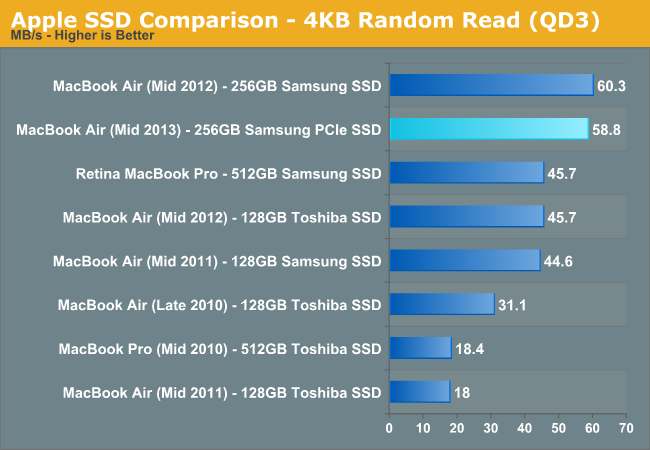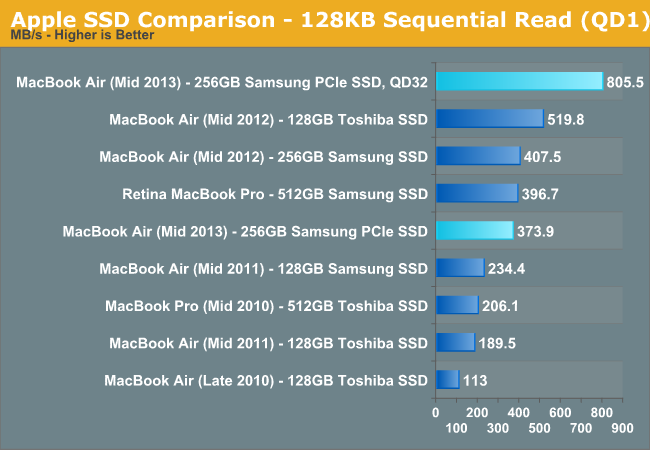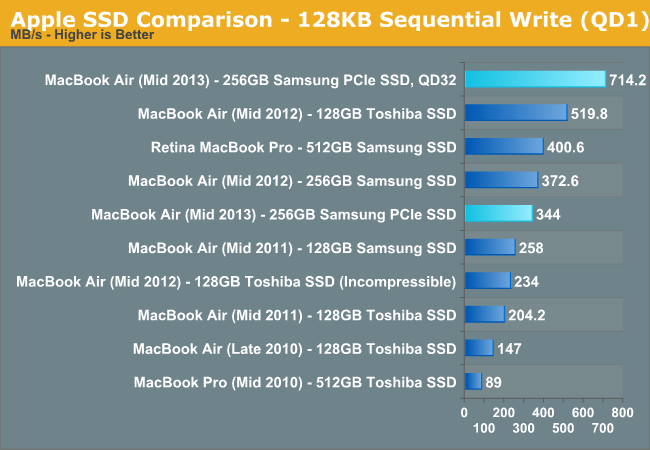The 2013 MacBook Air Review (13-inch)
by Anand Lal Shimpi on June 24, 2013 12:01 AM ESTPCIe SSD Performance
I created a Boot Camp partition of around 120GB and ran our client iometer benchmarks to put the new PCIe SSD’s performance in perspective.
Peak random read performance is roughly comparable to the previous-generation Samsung controller. Random write performance took a bit of a hit but it's still more than fast enough for client workloads. Sequential speeds are much improved but the gains are really only visible at high queue depths. Low queue depth sequential transfers can’t be split up enough in order to really require PCIe.




What does this mean in the real world? The new SSD is definitely snappier in system use. Wake from sleep is a bit quicker, as are application launches. The funny thing is that with the exception of high-speed Thunderbolt arrays, most external sources aren’t fast enough to even stress the new storage subsystem in the MacBook Air. Large file copies confined to the drive itself benefit a bit as well. I saw roughly 300MB/s reads and 300MB/s writes when copying a large dmg from/to the MacBook Air’s PCIe SSD (compared to roughly 200/200MBps on the old Samsung SATA SSD from the rMBP15).
If you have an external Thunderbolt array with at least a couple of drives, you should have no issues matching the MBA’s internal SSD performance.
Seeing as how this is our first experience with Samsung’s PCIe SSD controller, I wanted to get a feel for how the drive behaved under extended high queue depth random writes. I ran a modified version of our IO consistency test. The test was modified to run in a 91GB space on the MBA’s Boot Camp partition. I made sure to fill the rest of the drive completely, but the random writes were effectively constrained to 91GB of LBAs. When I get back from the UK I’m going to try setting up an external boot drive and will do some more extensive testing on the drive.
The IO consistency results, at least within a somewhat constrained space actually look really good. I have a feeling that Samsung might have improved its IO consistency story with this generation, but I’ll wait on saying for sure until I’ve had a chance to do some more work with the controller. For the vast majority of users however, solid random write performance like this over a 91GB space on a full drive is actually very good news.













233 Comments
View All Comments
malcolmcraft - Thursday, October 9, 2014 - link
MacBook Air is absolutely fantastic! It is also interesting that it's the highest rated laptop among consumers (see http://www.consumertop.com/best-laptop-guide/)... I would not trade mine for anything.darwinosx - Monday, July 8, 2013 - link
If you read the review you are commenting on you would know its not a terrible display.Subyman - Monday, June 24, 2013 - link
Did you even read Anand's article? He explains why.sigmatau - Monday, June 24, 2013 - link
Yes, apparently it is good to have a long battery life so you can be able to stare at a horrible display for as long as possible. I'd rather have that display in a $400 laptop. Actually, not even at that price point.designerfx - Monday, June 24, 2013 - link
exactly. I laugh when people look at GPU performance when they forget that it's at 1366x768. You can get better (and AMD does) in IGP.josef195 - Tuesday, August 20, 2013 - link
I laugh when people complain about good GPU performance at 1366x768 when it's actually 1440x900jmmx - Monday, June 24, 2013 - link
hardly a horrible display! Have you ever seen one? Not only are they very fine - though admittedly not as high resolution as others, but according to one monitor expert - only Apple displays have a consistency and an out-of-the-box color setting that is very close to professionally calibrated.sigmatau - Tuesday, June 25, 2013 - link
OK, I will say that Apple offers some of the best displays, but the best 1366x768 display is still terrible even on a 13" display. Not sure why Apple didn't go with a 1080p display with haswell since any increase battery waste from the display should be more than mitigated by the increased efficiency of the CPU/GPU. It's not like anyone does any serious gaming on these laptops so a higher resolution display will not be affected there either.KitsuneKnight - Tuesday, June 25, 2013 - link
The display is 1440x900 on the 13", not 1366x768 (that's the 11"). It's also one of the damn nicest displays I've ever had the pleasure of using (even the viewing angles doesn't bother me, maybe because it's the only laptop I've used with a decent henge).Personally, I'd opt for a 12 hour battery life over a retina-class display. Ideally, I'd have both, but it'll be quite a while before that becomes a possibility in any machine like the Air.
ThreeDee912 - Monday, June 24, 2013 - link
I'm not sure if it's the same panel, but the 2010 and 2011 reviews tested the LCD, and the panels had some of the best contrast ratios and black/white levels out of any TN panels at the time. It's no IPS, but they're still pretty darn good compared to everything else. While it would be nice if Apple made the panels IPS, I think the current panel resolution is fine.http://www.anandtech.com/show/3991/apples-2010-mac...
http://www.anandtech.com/show/4528/the-2011-macboo...
Also, I'm not sure why some people want to run an unscaled UI on super high-res panels, especially on laptops of this size. Yes, some smartphones have higher resolutions screens, but they scale things up so it's easier to read. Just stuffing in a high-res panel for the heck of it isn't the way to do things.